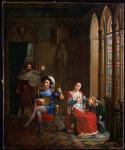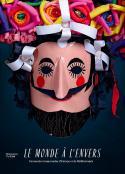Art Of The Day Weekly
#342 - from 17 April 2014 to 23 April 2014
IN THE AIR
How Matisse, when older, reinvented colour
LONDON – Matisse was bed-ridden, and weak. It was the end. Not at all! In 1947, in his bed and his pain he cut out coloured papers and had the nurse glue them to the wall. He actually perfected a new technique that kept him busy his last years. Actually, as is seen in this major exhibit at the Tate Modern, the limit is not so clear: Matisse carried out his first experiences in this field as of the 1930s, and we all know his superb later oil paintings, his open windows on luminous gardens. Nevertheless, from 1947 up to his death in 1954, these cut out papers were his main operating mode. The famous Escargot, which the Tate bought in 1962, is obviously present, but it is accompanied by nearly 120 other works: the original drawings of the artist’s book Jazz, the four very famous Nus bleus, grouped together exceptionally, the covers of the magazine “Verve” published by Tériade, la Gerbe and the gigantic Grande décoration aux masques (1953), on loan from the National Gallery in Washington – 10 meters long! A few months before his demise, Matisse was more ambitious than ever…
• Henri Matisse, the Cut-Outs at the Tate Modern, from 17 April to 7 September 2014.
EXHIBITIONS

Louis Julien Aulnette du Vautenete (1786–1863), The Return of thé Pilgrim, 1818, oil on canvas, 46,7x 38,5 cm. Rennes, musée des Beaux-Arts. Photo © RMN-Grand Palais / Louis Deschamps
My love, the troubadour
LYON and BOURG-EN-BRESSE – At the beginning of the XIXth century interest was awoken on a period which till then had been looked down upon, the Middle Ages Age. How could they represent those events and above all its setting? That was the question a new school of art asked itself, stimulated by the editorial production of Horace Walpole, Walter Scott and others such as Mary Shelley. Lyon was particularly dynamic in this field, and gave birth to the «troubadour» style ,which brings back to life the atmosphere of the former centuries, of its gentle ladies and the knights tournaments, with an abundance of details (donjons and guard rooms, hangings and furniture, cloths and materials, etc.), that were not always authentic. These artists, hidden by Ingres’ success, are forgotten today, even the most notorious representatives such as Pierre Révoil (1776-1842) or Fleury Richard (1777-1852). They have been ‘ressurected’ today in two different places which have enriched their collections over the last forty years. The international dimension is important as the genre had a European branch, with Leighton, Palagi, Rosales and their sidekicks, who produced endlessly Dürer at his balcony in his house in Nuremberg, François Ist visiting the workshop of Benvenuto Cellini and Dementia of Juana of Castile among others.
• L’invention du passé, histoires de cœur et d’épée en Europe, 1802-1850 at the musée des Beaux-Arts in Lyon, from 19 April to 29 July 2014.
• L’invention du passé, gothique mon amour, 1802-1830 at the royal monastery of Brou, from 19 April to 21 September 2014.
Mapplethorpe faces Rodin
PARIS – The same fascination for the body, the same taste for breaking away from conventions. The unexpected rapprochement between Rodin’s statues and Mapplethorpe’s photographs is done in seven sections, between Movement and Damnation.
• Mapplethorpe-Rodin at the musée Rodin, from 8 April to 21 September 2014.
The Palatine of Florence
FLORENCE- Before becoming through her marriage Electrice Palatine, Anna Maria Luisa (1667-1743) was a Medici, brought up in the Tuscan capital. She is remembered with passion in this exhibition and in general, by the defenders of the national heritage. Indeed it was she, who through a family pact with the reigning dynasty in Lorraine, managed to have the masterpieces from the Grand Duchy never leave Florence.
• Arte e politica at the Museo delle Cappelle Medicee, from 8 April to 2 November 2014.
Dix declares war to war
DRESDEN - War, a large triptych 4 meters long, is one of the major works by Otto Dix, who fought in World War I and turned it into an obsessional theme, sometimes a long time later , that is between 1929 and 1932. It is presented with the preparatory works and the 50 prints from the series with the same name that were finished earlier, in 1924.
• Otto Dix, Der Krieg at the Staatliche Kunstsammlungen, from 5 April to 13 July 2014.
AUCTIONS
Russian passions
PARIS – The auction of the library of José Johannet (1924-2013), a student of Pierre Pascal and one of the first graduates with a doctorate in Russian France, will interest Slavophiles – whether they like the Czar or Trotsky… The former will prefer Bibliothèque antique russe by Nicolas Novikoff (1775), the latter a rare plate dedicated by Trotski in 1918 to the organisation of the Red Army (€500). The diversity of subjects Johannet was interested in can be seen in the contents of his library, in which an original edition (1855) of Dead Souls by Gogol, sits next to the Complete Geographical Description of our Country, published in 11 volumes between 1899 and 1914 (€500) and the numerous editions of Russian writers published in Germany at the beginning of the 1920s, from Pushkin to Leon Chestov. We will also admire avant-garde magazines such as Lef (“Left”), directed by Maïakovski and the covers of which were designed by Rodchenko. The historical 1st issue of 1924, censored at the time and thus losing the editorial “Do not act like Lenin”, supposedly because of the Bolshevik leader’s recent death, is a rare item (€1000).
• Bibliothèque russe at the hôtel Drouot on 23Apvril 2014 (Tajan).
ARTIST OF THE WEEK
Mirza sings le Corbusier
It is quite legitimate to want historical monuments to live side by side with contemporary creations. But it does not only concern medieval abbeys. The announced event in Villa Savoye, a true manifest designed by Le Corbusier between 1928 and 1931, proves this. Located in the Paris suburb of Poissy, it was close to been demolished in the 1960s. It was then saved and restored, and will host British artist Haroon Mirza (born in 1977, the Golden Lion at the Biennale of Venice in 2011). He will be giving it a sound environment. Like in the case of the Erik Samakh’s flutes, light nourishes the synthesizers and produces a melody at certain moments. The original aspect f the artist’s creation, sponsored by the Lab’bel of the Bel Group, is also due to his way of valuing space: blindfolded he has decided to choose each of his passages, and decided to approach the location…
• Haroon Mirza, the Light Hoursat Villa Savoye, from 3 April to 29 June 2014.
OPENINGS OF THE WEEK
BOOKS
Europe at carnival time
The heir of the former museum of popular Arts and Traditions (in Paris) which marked an important phase in the world of museums in the XXth century, the Mucem in Marseilles must honour its memory. It does it just a few months after being inaugurated, with an exhibition that screens the survival of carnivals throughout the world. In the past it was a ritual, with its own codes, and religion tried to tear it away from paganism. In general it has become a folklore that has lost the keys to its understanding, except when it became politics. The puppets of Sarkozy, of Nazi military (during the much criticized edition of the carnival of Alost in Belgium in 2013) or the chariot of the “Greek loans” in the carnival of Nice are immediately identifiable. More than once they replaced the bears, devils or « conards » of Rouen, figures of transgression that symbolised initiation rituals. From Israel to Lithuania, from Sardinia to Iran, the choice is very wide and greatly illustrated.
• Le monde à l’envers, Mucem/Flammarion, 2014, 336 p., €39.90.


